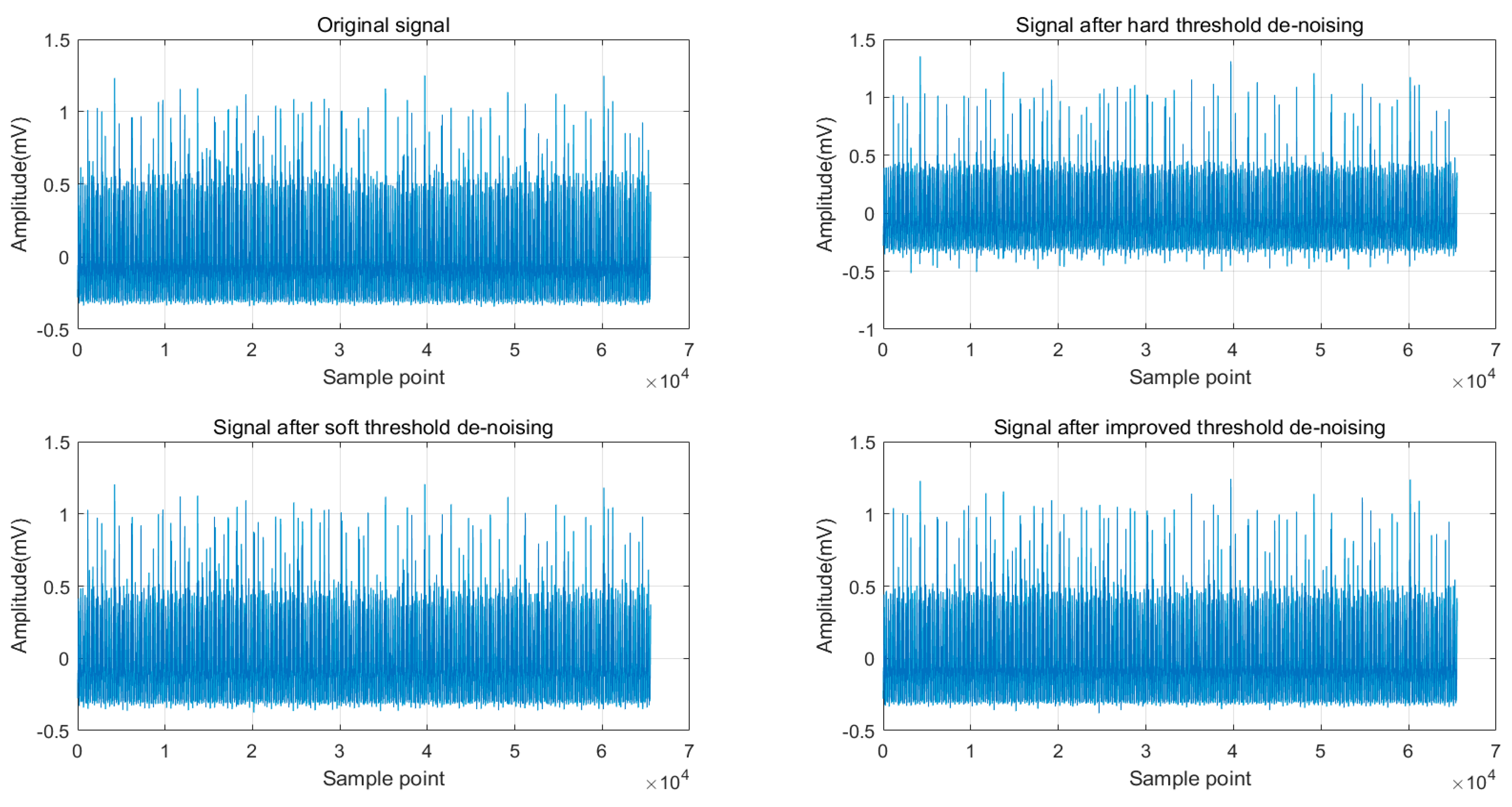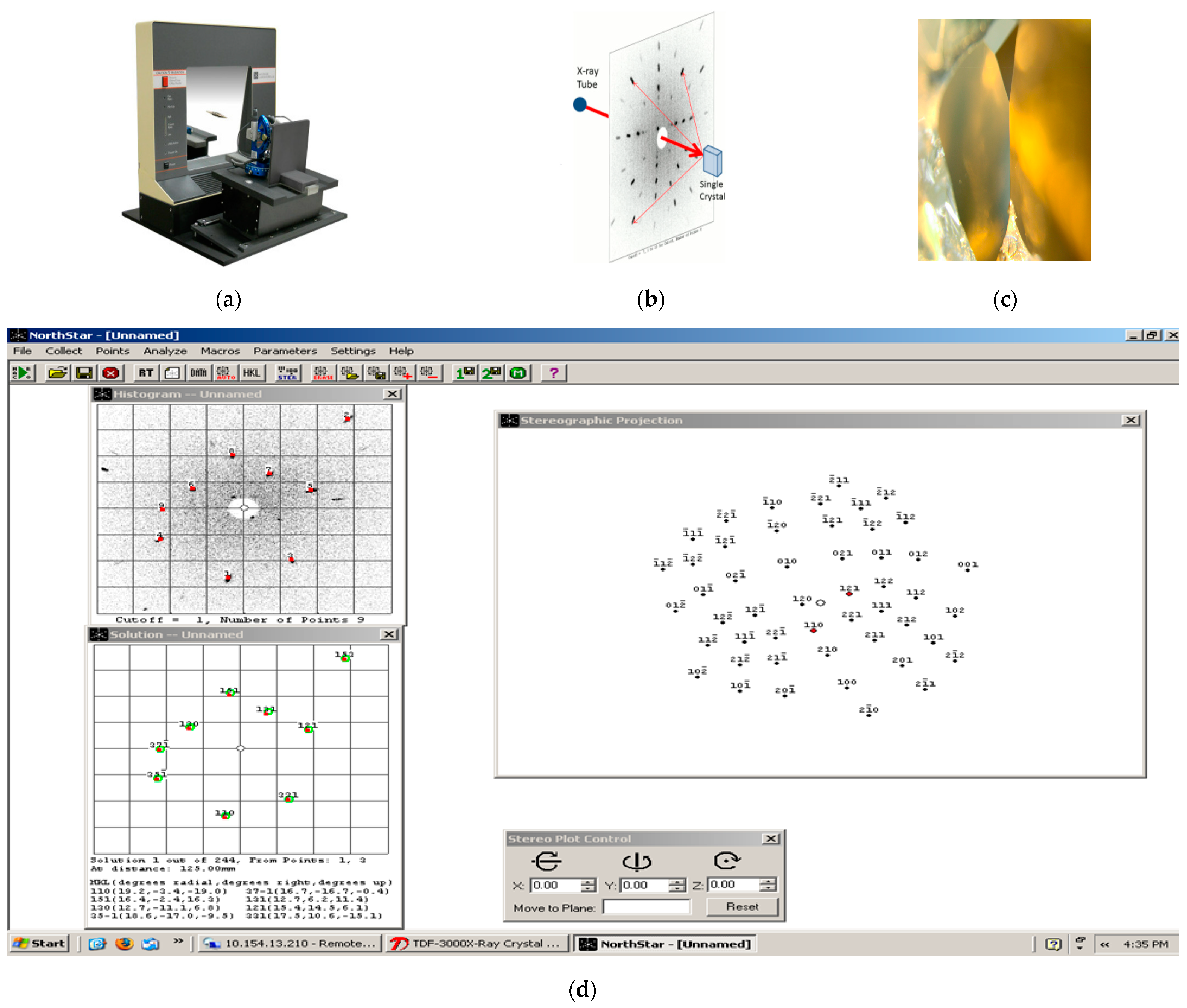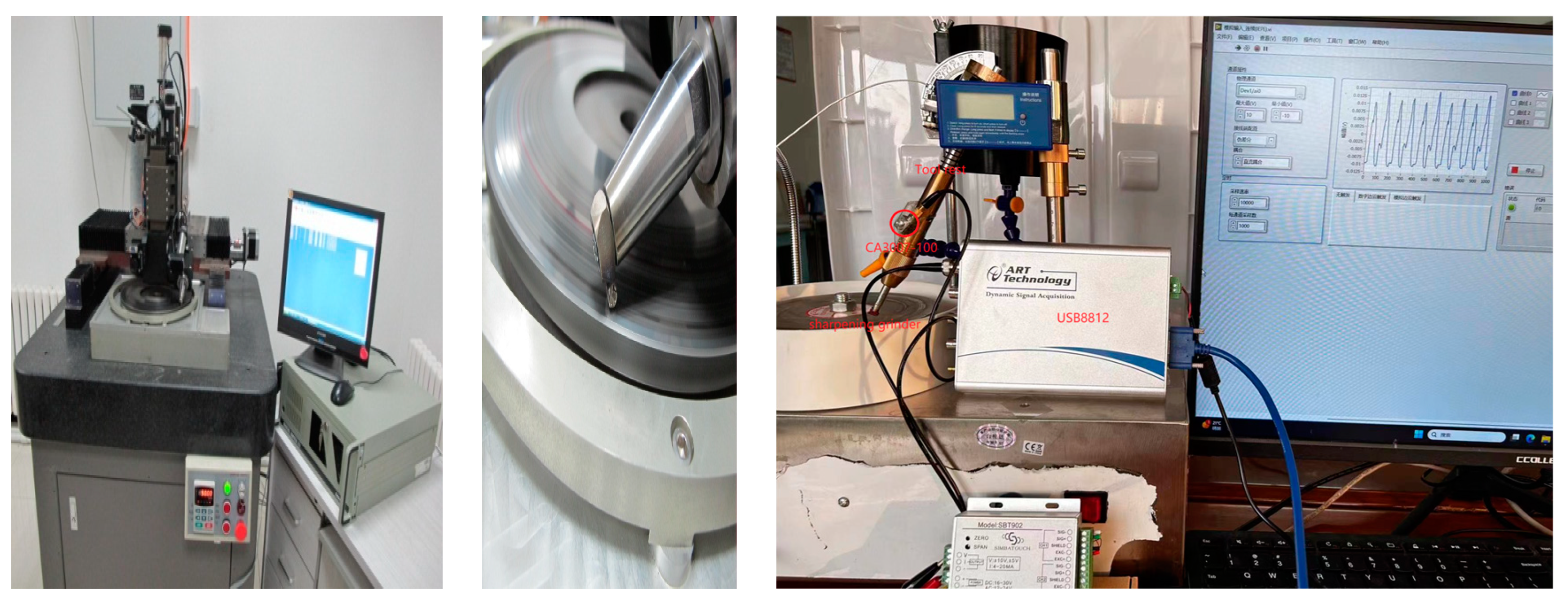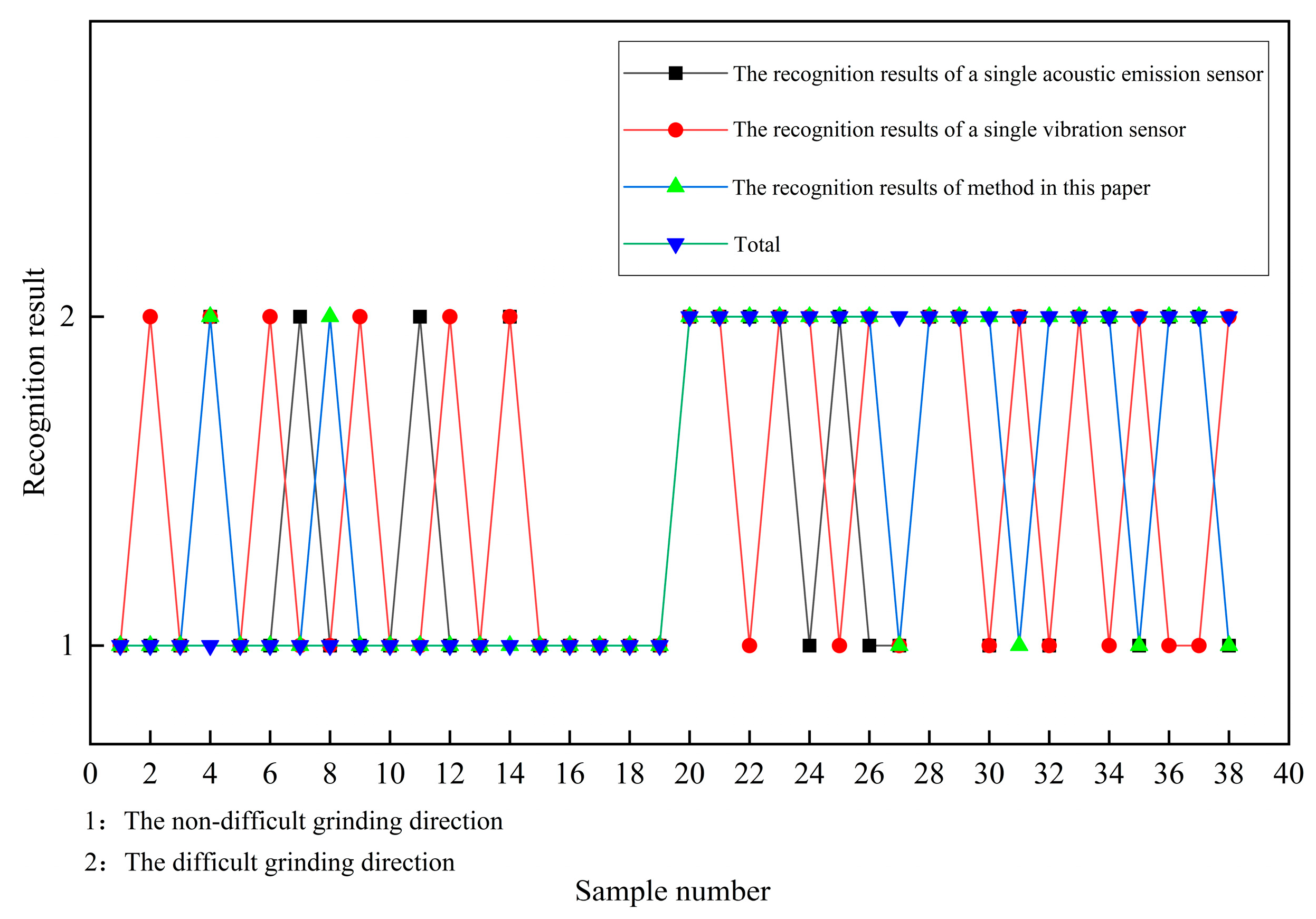Online Orientation Recognition of Single-Crystal Diamond Tools in the Process of Indexing Grinding Based on HMM and Multi-Information Fusion
Abstract
1. Introduction
2. Characteristic Signal Selection and Wavelet Denoising Processing
2.1. Characteristic Signal Selection
2.2. Wavelet Denoising
2.2.1. Basic Principle
2.2.2. Selection of the Wavelet Basis
2.2.3. Choice of Decomposition Scale
2.2.4. Selection and Improvement of the Threshold Function
2.2.5. Analysis of Wavelet Denoising Simulation Results
3. Time Domain Analysis of Characteristic Signal
4. Online Recognition Based on the Hidden Markov Method
4.1. Hidden Markov Online Orientation Recognition Model
4.2. Online Identification Method
5. Experimental Verification and Analysis
5.1. Experimental Platform
5.2. Model Training and Orientation Recognition
5.3. The Experimental Results
6. Conclusions
- (1)
- Sound signal analysis technology and vibration signal analysis technology are comprehensively applied to the online orientation identification of a single-crystal diamond tool in the indexing grinding process, and the noise signal is removed by the wavelet method by improving the wavelet threshold function. The signal-to-noise ratio reached 21.815345 dB, the signal-to-noise ratio of the proposed method is greater than the hard threshold and soft threshold functions, and the denoising effect is better, while more useful signal components are retained.
- (2)
- The time domain analysis method is used to analyze the mapping relationship between the time domain characteristic parameters of the vibration signal, sound signal, and the tool grinding direction. By theoretical analysis and experiments, it is determined that the kurtosis value of the sound signal, the kurtosis value, and the skewness of the vibration signal are strongly correlated with the tool grinding direction. Therefore, they are used as characteristic parameters.
- (3)
- The Hidden Markov Method is used to fuse the feature parameters and establish the HMM model of the difficult grinding direction and the non-difficult grinding direction. The experimental results show that the recognition method combining HMM and multi-information fusion technology has a greater advantage than single-sensor recognition, and the recognition rate reached 84.21%, which provides a new method for the online identification of the direction in the indexing grinding process of the single-crystal diamond arc tool.
Author Contributions
Funding
Institutional Review Board Statement
Informed Consent Statement
Data Availability Statement
Conflicts of Interest
References
- Hird, J.R.; Field, J.E. Diamond polishing. Proc. R. Soc. A Math. Phys. Eng. Sci. 2004, 460, 3547–3568. [Google Scholar] [CrossRef]
- EWAG RS15 Operation Manual; EWAG Inc.: Tübingen, Germany, 2010.
- PG3B Operation and Maintenance Manual; Coborn Engineering Co. Ltd.: Romford, UK, 2011.
- Zhou, T. Research on Monitoring Technology of Natural Diamond Tool Grinding Process. Master’s Thesis, Chinese Academy of Engineering Physics, Beijing, China, 2007. [Google Scholar]
- Du, W. Processing Characterization and Experimental Study of Acoustic Emission Signals from Grinding Diamond Cutters. Ph.D. Thesis, Harbin Institute of Technology, Harbin, China, 2015. [Google Scholar]
- Du, W.; Sun, T.; Wang, B. Diamond tool grinding non-gaussian characteristics of acoustic emission signal analysis. J. Nanotechnol. Precis. Eng. 2015, 13, 211–218. [Google Scholar]
- Jiang, C.; Ya, X.; Mao, Y. The application of improved wavelet threshold denoising method in vibration and high dynamic centrifugal compound test control system. Equip. Environ. Eng. 2024. Available online: http://kns.cnki.net/kcms/detail/50.1170.X.20240418.1817.006.html (accessed on 5 January 2023).
- Song, Y.; Zhang, Y. Bearing fault feature Extraction Method using CEEMD noise reduction and adaptive MOMEDA. Chin. J. Test. 2019, 50, 180–188. [Google Scholar]
- Wei, L.; Wei, L.; Jia, Y.; Yiwen, B. Vehicle acceleration signal processing with improved Wavelet threshold noise reduction. Automot. Driv. Maint. (Maint. Ed.) 2024, 29–32. [Google Scholar]
- Li, J.; Cui, X.; Song, H.; Li, Z.; Liu, J. Threshold selection method for UWB TOA estimation based on wavelet decomposition and kurtosis analysis. EURASIP J. Wirel. Commun. Netw. 2017, 2017, 202. [Google Scholar] [CrossRef]
- Li, Z. Study on time domain analysis method of Gearbox taper bearing fault signal. Mech. Des. Manuf. 2024. [CrossRef]
- Shang, Z.; Zhao, D. Based on the vibration analysis of papermaking machinery fault diagnosis and monitoring research. J. Pap. Sci. Technol. 2024, 43, 111–114+122. [Google Scholar] [CrossRef]
- Yan, R.; Ma, G.; Chen, X. Single crystal diamond tool. Mech. Grind. Technol. Prog. Tool Technol. 2016, 50, 8–11. [Google Scholar]
- Xia, Y.Y.; Meng, J.; Xue, Y.C. Fault diagnosis of Hidden Markov ball mill based on improved Bat algorithm. Mod. Min. 2022, 38, 195–199. [Google Scholar]
- Lu, H.; Li, Y. Acquisition and processing method of Low voltage Distribution line Operating state Information based on Markov Model. J. Electr. Appl. 2019, 42, 101–106. [Google Scholar]
- Yuan, L.; Long, H.; Li, B. Construction and application of complex evolutionary network model of mine water disaster chain based on HMM algorithm. Miner. Chem. Process. 2023, 52, 47–55. [Google Scholar]






| Wavelet Basis | Noise Reduction Result SNR/dB | Noise Reduction Result RMSE/Hz |
|---|---|---|
| db1 | 10.1958 | 0.00920 |
| db2 | 11.1603 | 0.00820 |
| db3 | 11.6899 | 0.00770 |
| db4 | 11.9757 | 0.00750 |
| db5 | 12.1826 | 0.00730 |
| db6 | 12.3382 | 0.00720 |
| db7 | 12.4406 | 0.00710 |
| db8 | 12.5423 | 0.00700 |
| db9 | 12.5185 | 0.00700 |
| Different Threshold Functions | Signa-to-Noise Ratio |
|---|---|
| Hard threshold function | 15.073503 dB |
| Soft threshold function | 20.661766 dB |
| Improved threshold function | 21.815345 dB |
| Grinding Direction | Grinding Efficiency K |
|---|---|
| Difficult grinding direction | 0–2 |
| The direction between difficult grinding and easy grinding | 2–4 |
| Easy grinding direction | 4–6 |
| Sharpening Direction | Sample Number | Mean Value | Variance | Skewness | Kurtosis |
|---|---|---|---|---|---|
| Non-difficult grinding direction | 1 | 0.764 | 0.008 | 0.356 | 2.906 |
| 2 | 0.782 | 0.007 | 0.213 | 3.156 | |
| 3 | 0.762 | 0.005 | 0.451 | 3.331 | |
| 4 | 0.776 | 0.004 | −0.098 | 3.815 | |
| Difficult grinding direction | 1 | 0.801 | 0.003 | 0.352 | 5.123 |
| 2 | 0.791 | 0.004 | 0.459 | 5.601 | |
| 3 | 0.800 | 0.006 | 0.661 | 5.779 | |
| 4 | 0.786 | 0.005 | −0.589 | 4.613 |
| Sharpening Direction | Sample Number | Mean Value | Variance | Skewness | Kurtosis |
|---|---|---|---|---|---|
| Non-difficult grinding direction | 1 | 0.782 | 0.005 | 0.036 | 2.850 |
| 2 | 0.781 | 0.007 | 0.011 | 3.213 | |
| 3 | 0.761 | 0.004 | 0.045 | 2.954 | |
| 4 | 0.752 | 0.006 | −0.026 | 3.704 | |
| Difficult grinding direction | 1 | 0.810 | 0.002 | 0.352 | 6.121 |
| 2 | 0.715 | 0.004 | 0.459 | 5.458 | |
| 3 | 0.801 | 0.003 | 0.661 | 5.623 | |
| 4 | 0.7890 | 0.007 | 0.785 | 4.923 |
| (a) | |||
| Sharpening direction | Number of test samples | Correct number of recognition results | Accuracy rate (%) |
| Non-difficult grinding direction | 19 | 15 | 78.94 |
| Difficult grinding direction | 19 | 12 | 63.15 |
| Total | 38 | 27 | 71.05 |
| (b) | |||
| Sharpening direction | Number of test samples | Correct number of recognition results | Accuracy rate (%) |
| Non-difficult grinding direction | 19 | 13 | 68.42 |
| Difficult grinding direction | 19 | 11 | 57.89 |
| Total | 38 | 24 | 63.16 |
| (c) | |||
| Sharpening direction | Number of test samples | Correct number of recognition results | Accuracy rate (%) |
| Non-difficult grinding direction | 19 | 17 | 89.47 |
| Difficult grinding direction | 19 | 15 | 78.94 |
| Total | 38 | 32 | 84.21 |
Disclaimer/Publisher’s Note: The statements, opinions and data contained in all publications are solely those of the individual author(s) and contributor(s) and not of MDPI and/or the editor(s). MDPI and/or the editor(s) disclaim responsibility for any injury to people or property resulting from any ideas, methods, instructions or products referred to in the content. |
© 2024 by the authors. Licensee MDPI, Basel, Switzerland. This article is an open access article distributed under the terms and conditions of the Creative Commons Attribution (CC BY) license (https://creativecommons.org/licenses/by/4.0/).
Share and Cite
Ma, H.; Xia, D.; Wu, Y. Online Orientation Recognition of Single-Crystal Diamond Tools in the Process of Indexing Grinding Based on HMM and Multi-Information Fusion. Appl. Sci. 2024, 14, 4236. https://doi.org/10.3390/app14104236
Ma H, Xia D, Wu Y. Online Orientation Recognition of Single-Crystal Diamond Tools in the Process of Indexing Grinding Based on HMM and Multi-Information Fusion. Applied Sciences. 2024; 14(10):4236. https://doi.org/10.3390/app14104236
Chicago/Turabian StyleMa, Haitao, Dayu Xia, and Yifan Wu. 2024. "Online Orientation Recognition of Single-Crystal Diamond Tools in the Process of Indexing Grinding Based on HMM and Multi-Information Fusion" Applied Sciences 14, no. 10: 4236. https://doi.org/10.3390/app14104236
APA StyleMa, H., Xia, D., & Wu, Y. (2024). Online Orientation Recognition of Single-Crystal Diamond Tools in the Process of Indexing Grinding Based on HMM and Multi-Information Fusion. Applied Sciences, 14(10), 4236. https://doi.org/10.3390/app14104236





